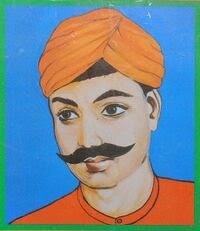Introduction
The Sapta Sindhu (Sanskrit: सप्त सिंधु, “Seven Rivers”) of the Rigveda and the Hapta Hindu of the Zend Avesta are pivotal concepts in the study of early Indo-Iranian civilization, referring to a region defined by seven major rivers in the northwestern Indian subcontinent. These terms, rooted in a shared Indo-Iranian linguistic and cultural heritage, highlight a riverine landscape that shaped the religious, social, and economic lives of the Vedic Aryans and their Iranian counterparts. This article critically examines the geographical similarities and extent of Sapta Sindhu and Hapta Hindu, the modern countries spanned by these rivers, the time of composition of the Vedas, and the absence of Vedic inscriptions in the Indus Valley Civilization (IVC). It further explores Indo-Iranian migrations, trade networks, and cultural exchanges, drawing on textual, archaeological, and linguistic evidence while maintaining a skeptical approach to unverified claims. The expanded analysis addresses the geopolitical context of the rivers and evaluates competing hypotheses to provide a comprehensive understanding of these regions.

Table of Contents
Time of Composition of the Vedas
The Vedas—comprising the Rigveda, Samaveda, Yajurveda, and Atharvaveda—are among the oldest sacred texts of Hinduism, composed in Vedic Sanskrit. Their composition is dated based on linguistic, textual, and archaeological evidence, as no direct inscriptions or edicts mention the Vedas in the IVC or other contemporary records, despite the IVC’s use of a writing system.

- Rigveda: Composed approximately between 1500–1000 BCE, the Rigveda is the earliest Veda. This dating is supported by:
- Linguistic Evidence: Its archaic Sanskrit, with pitch accent and complex morphology, predates later Sanskrit texts (e.g., Panini’s grammar, c. 500 BCE) and aligns closely with Avestan, suggesting a shared Indo-Iranian origin around 2000–1500 BCE.
- Textual Content: Hymns describe a pastoralist society with bronze technology and chariots, consistent with the Late Harappan period (c. 1900–1300 BCE) and the Painted Grey Ware (PGW) culture (c. 1200–600 BCE). Later hymns mention iron, aligning with the Iron Age (post-1200 BCE).
- Archaeological Context: The absence of urban descriptions in early hymns suggests a post-IVC context, while references to rivers like the Sarasvati align with the Ghaggar-Hakra’s active phase before 1900 BCE.
- Samaveda, Yajurveda, and Atharvaveda: Likely composed between 1200–800 BCE, these texts reflect more complex rituals and settled agricultural societies, consistent with Indo-Aryan expansion into the Gangetic plain.
- Oral Transmission: The Vedas were transmitted orally for centuries, likely written down only in the 1st millennium CE using Gupta-period scripts. The absence of Vedic inscriptions in the IVC (c. 3300–1300 BCE) suggests either a later composition or a deliberate oral tradition, as writing was considered profane for sacred texts in early Vedic culture.
Critical Note: The lack of epigraphic evidence linking the Vedas to the IVC, despite its undeciphered script, complicates claims of continuity. Scholars like Romila Thapar argue that the Vedas reflect a pastoralist society distinct from the IVC’s urbanism, while others, like B.B. Lal, propose Vedic elements in IVC fire altars. Without deciphered IVC texts, such claims remain speculative, requiring cautious interpretation.
Geographical Context and Similarities of Sapta Sindhu and Hapta Hindu
Sapta Sindhu in the Rigveda
The Sapta Sindhu is a central motif in the Rigveda, referring to a region defined by seven rivers in the northwestern Indian subcontinent. These rivers, celebrated as sacred and life-giving, are listed in hymns like the Nadistuti Sukta(Rigveda 10.75) and include:
- Sindhu (Indus): The primary river, flowing through modern-day Pakistan and northwestern India.
- Vitasta (Jhelum): A tributary of the Indus, in Jammu and Kashmir (India) and Pakistan.
- Asikni (Chenab): Another Indus tributary, flowing through Jammu and Kashmir and Punjab (Pakistan).
- Parushni (Ravi): A river in Punjab, India, and Pakistan.
- Vipas (Beas): A river in Himachal Pradesh and Punjab, India.
- Shutudri (Sutlej): The longest Punjab river, originating in Tibet (China) and flowing through India and Pakistan.
- Sarasvati: Often identified with the Ghaggar-Hakra river system in Haryana, Rajasthan (India), and Pakistan, though its exact course is debated due to its drying around 1900 BCE.

Geographical Extent:
- The Sapta Sindhu encompasses the Punjab region (modern-day Punjab in India and Pakistan), parts of Haryana, Rajasthan, and northwestern India. The Rigveda describes a fertile landscape supporting pastoralism and early agriculture, with the Sarasvati as a cultural and religious focal point (Rigveda 2.41.16).
- Archaeological Correlation: The region aligns with IVC sites like Harappa (Ravi), Mohenjo-Daro (Indus), and Rakhigarhi (Ghaggar-Hakra), suggesting Indo-Aryan interaction with Late Harappan populations. Geological studies (e.g., Giosan et al., 2012) confirm the Ghaggar-Hakra’s active phase during the IVC, supporting its identification as the Sarasvati.
Hapta Hindu in the Zend Avesta
The Hapta Hindu appears in the Vendidad (Fargard 1.18) of the Zend Avesta, listed as the fifteenth of sixteen lands created by Ahura Mazda. The term (hapta = seven, həndu = river) is linguistically cognate with Sapta Sindhu, reflecting a shared Indo-Iranian heritage. The Avesta notes Hapta Hindu’s “abnormal heat,” consistent with the region’s warm climate.
Geographical Identification:
- Hapta Hindu likely refers to the same region as Sapta Sindhu, centered on the Indus River system in modern-day Pakistan, northwestern India, and eastern Afghanistan. The Avestan Haraxvati, cognate with Sarasvati, suggests a shared memory of a sacred river.
- Rivers: The Avesta does not explicitly list the seven rivers, but scholars infer they include the Indus, Jhelum, Chenab, Ravi, Beas, Sutlej, and either the Sarasvati (Ghaggar-Hakra) or the Kabul River, which flows through Afghanistan and Pakistan.
Geographical Extent:
- The Hapta Hindu likely encompasses the Punjab region, parts of Sindh (Pakistan), and eastern Afghanistan, potentially extending to the Kabul River valley. The Avesta’s broader geographical framework, including lands like Airyanem Vaejah (possibly Central Asia), positions Hapta Hindu as a peripheral but familiar region.
Geographical Similarities
The Sapta Sindhu and Hapta Hindu share striking geographical similarities, rooted in their shared Indo-Iranian cultural and linguistic framework:
- Core Region: Both terms describe a region centered on the Indus River system, including its major tributaries (Jhelum, Chenab, Ravi, Beas, Sutlej). This riverine landscape defines the Punjab region, a fertile plain supporting agriculture and pastoralism.
- Sarasvati/Haraxvati: The Vedic Sarasvati and Avestan Haraxvati are linguistic cognates, likely referring to the Ghaggar-Hakra river system. Both texts elevate this river to a sacred status, suggesting a shared cultural memory of a once-mighty waterway.
- Riverine Focus: Both traditions emphasize the seven rivers as life-giving and divine, with the Rigveda personifying them as deities (e.g., RV 7.36.6) and the Avesta including Hapta Hindu in a cosmological list, indicating its significance.
- Geographical Overlap: The core area of both regions spans the Punjab (India and Pakistan), with extensions to Haryana, Rajasthan, and eastern Afghanistan. The inclusion of the Kabul River in some interpretations of Hapta Hindu slightly broadens its scope compared to Sapta Sindhu.
Differences:
- Cultural Emphasis: The Rigveda focuses on the Sapta Sindhu as the heartland of Vedic civilization, with detailed hymns to each river. The Avesta treats Hapta Hindu as one of many lands, suggesting a more distant or symbolic role.
- River Identification: The Rigveda explicitly names the seven rivers, while the Avesta’s lack of specificity leaves room for debate about whether the Kabul River or another replaces the Sarasvati.
- Climatic Description: The Avesta’s mention of “abnormal heat” aligns with the Punjab’s climate but contrasts with the Rigveda’s focus on fertility, possibly reflecting different environmental perceptions.
Countries Spanned by the Seven Rivers
The seven rivers associated with Sapta Sindhu and Hapta Hindu flow through multiple modern countries, reflecting the region’s geopolitical complexity:
- Indus (Sindhu): Originates in Tibet (China), flows through Ladakh (India), and empties into the Arabian Sea in Sindh (Pakistan). Countries: China, India, Pakistan.
- Jhelum (Vitasta): Originates in Jammu and Kashmir (India), flows through Pakistan-administered Kashmir and Punjab (Pakistan). Countries: India, Pakistan.
- Chenab (Asikni): Begins in Himachal Pradesh (India), flows through Jammu and Kashmir (India) and Punjab (Pakistan). Countries: India, Pakistan.
- Ravi (Parushni): Starts in Himachal Pradesh (India), flows into Punjab (Pakistan). Countries: India, Pakistan.
- Beas (Vipas): Originates in Himachal Pradesh (India), flows entirely within India before joining the Sutlej. Country: India.
- Sutlej (Shutudri): Begins in Tibet (China), flows through Himachal Pradesh and Punjab (India), and into Punjab (Pakistan). Countries: China, India, Pakistan.
- Sarasvati (Ghaggar-Hakra): Identified with the Ghaggar-Hakra, originates in Haryana (India), flows through Rajasthan (India), and dries up in Cholistan (Pakistan). Countries: India, Pakistan.
- Kabul River (Alternative for Hapta Hindu): Originates in the Hindu Kush (Afghanistan), joins the Indus in Pakistan. Countries: Afghanistan, Pakistan.
Total Countries: The seven rivers collectively span three countries (India, Pakistan, China) for Sapta Sindhu, and potentially four countries (India, Pakistan, China, Afghanistan) if the Kabul River is included for Hapta Hindu. The core region (Punjab) is primarily in India and Pakistan, with the Sutlej’s origin in China and the Kabul River’s in Afghanistan extending the geopolitical scope.
Critical Note: The modern geopolitical boundaries did not exist in the Vedic or Avestan periods, and the rivers were part of a contiguous cultural landscape. The inclusion of Afghanistan for Hapta Hindu is speculative, as the Avesta’s reference to the Kabul River is not explicit. Geological changes, such as the drying of the Ghaggar-Hakra, further complicate precise mappings.
Indo-Iranian Migrations: Directions and Evidence
Proto-Indo-Iranian Origins
The Indo-Iranians, ancestors of the Vedic Aryans and Avestan Iranians, originated in the Sintashta culture (c. 2200–1900 BCE) in the Central Asian steppes (modern-day Russia and Kazakhstan). This culture, known for fortified settlements, horse domestication, and chariots, is evidenced by archaeological finds at sites like Sintashta and Arkaim. The Indo-Iranians split into Indo-Aryans and Iranians around 2000–1600 BCE, migrating southward.
Indo-Aryan Migration to Sapta Sindhu
- Timeline: Indo-Aryans arrived in the northwestern Indian subcontinent around 1700 BCE, during the Late Harappan period (c. 1900–1300 BCE).
- Route: From the steppes, they moved through the Bactria-Margiana Archaeological Complex (BMAC) in Turkmenistan and Uzbekistan, entering the Punjab via the Khyber Pass or other Afghan routes.
- Evidence:
- Textual: The Rigveda describes a pastoralist society with chariots (RV 1.162) and conflicts with indigenous groups like the Dasyus (RV 6.27), possibly Late Harappan populations.
- Archaeological: The Cemetery H culture (c. 1900–1300 BCE) and PGW culture (c. 1200–600 BCE) show continuity with IVC pottery but introduce horse remains (e.g., Swat Valley) and iron tools.
- Linguistic: Sanskrit’s similarity to Avestan indicates a recent divergence from Proto-Indo-Iranian.
- Critical Analysis: The “Aryan Invasion Theory” is largely discredited due to the lack of evidence for widespread violence. Scholars like Shereen Ratnagar suggest gradual migration and assimilation, with Indo-Aryans adopting IVC agricultural practices. The absence of Vedic inscriptions in the IVC supports a post-IVC composition or oral tradition.
Iranian Migration and Hapta Hindu
- Timeline: Iranians migrated to the Iranian Plateau and eastern Afghanistan around 2000–1300 BCE, with some groups possibly reaching the Sapta Sindhu region.
- Route: From the steppes, they settled in Bactria, Margiana, and Choresmia, with proximity to the Indus region via Afghanistan.
- Evidence:
- Textual: The Avesta’s mention of Hapta Hindu (Vendidad 1.18) suggests familiarity with the Indus region, possibly through trade or migration.
- Archaeological: The Yaz culture (c. 1500–1100 BCE) in Central Asia reflects Iranian settlement, with parallels to BMAC fire altars and IVC material culture.
- Linguistic: Avestan həndu and haraxvati are cognates with Vedic sindhu and sarasvati.
- Critical Analysis: The Avesta’s reference to Hapta Hindu does not confirm Iranian settlement, as it may reflect trade or cultural knowledge. The lack of Zoroastrian artifacts in the Punjab limits direct evidence.
Migration Directions and Materials Carried
- Indo-Aryans:
- Direction: Southeast from Central Asia to the Punjab, later spreading to the Gangetic plain (c. 800–500 BCE).
- Materials: Horses, chariots, bronze weapons, Vedic rituals (e.g., fire sacrifices), and Sanskrit. They adopted IVC pottery (e.g., PGW) and agriculture.
- Iranians:
- Direction: Southwest to the Iranian Plateau, with some groups in eastern Afghanistan near Hapta Hindu.
- Materials: Chariots, horses, Zoroastrian rituals (e.g., haoma), and Avestan.
- Critical Note: The absence of written records from migrating Indo-Iranians complicates tracing their movements. Horse remains and chariot burials (e.g., Sinauli, c. 1900 BCE) support technological continuity, but their attribution to Indo-Aryans is debated.
Cultural Exchange and Trade Networks
Cultural Exchange
The Sapta Sindhu and Hapta Hindu regions were hubs of cultural exchange due to their shared Indo-Iranian heritage:
- Religious Parallels: The Rigveda and Avesta share concepts like rta/asha (cosmic order), soma/haoma (ritual drink), and fire worship. The Vedic deva (god) and Avestan daeva (demon) reflect theological divergence.
- Linguistic Connections: Cognates like saptá síndhavaḥ/hapta həndu and sarasvatī/haraxvati indicate a shared vocabulary.
- Archaeological Evidence: BMAC fire altars and seals resemble IVC artifacts, suggesting exchange. Kalibangan’s fire altars may indicate Vedic influence, but their interpretation is speculative.
Critical Analysis: The shared heritage is evident, but direct exchange is uncertain due to the lack of inscriptions. The Avesta’s Hapta Hindu reference may reflect second-hand knowledge, and IVC fire altars lack textual corroboration for Vedic connections.
Trade Networks
The Sapta Sindhu region, part of the IVC, was a trade hub connecting Mesopotamia, Central Asia, and later Southeast Asia:
- IVC Trade (c. 2600–1900 BCE):
- Goods: Cotton textiles, lapis lazuli (Afghanistan), carnelian beads, and timber were exported to Mesopotamia. Imports included tin and copper.
- Evidence: Mesopotamian texts mention Meluhha (likely IVC), with IVC seals found in Bahrain and Ur.
- Post-IVC Trade (c. 1900–1000 BCE): Indo-Aryans and Iranians maintained trade via the Khyber Pass and maritime routes. Goods included textiles, metals, and precious stones.
- Critical Analysis: The IVC’s decline reduced long-distance trade, but overland routes persisted. The Avesta’s Hapta Hindu reference suggests trade knowledge, but direct evidence is sparse.
Absence of Vedic Inscriptions in the IVC
The IVC’s writing system, with over 400 signs, remains undeciphered, and no inscriptions mention the Vedas or Vedic deities:
- Oral Tradition: The Vedas were likely composed post-IVC and transmitted orally, explaining the lack of written records.
- Cultural Disconnect: The IVC’s urbanism contrasts with the Rigveda’s pastoralism, suggesting a later or distinct cultural phase.
- Archaeological Gaps: Fire altars at Kalibangan are cited as Vedic, but their interpretation is speculative. The absence of horse remains in mature IVC sites further complicates links.
Critical Note: Claims of Vedic presence in the IVC rely on circumstantial evidence. The undeciphered script and lack of epigraphic records necessitate skepticism about direct continuity.
Broader Impacts
- Southeast Asia: Indo-Aryan cultural influence spread via trade (c. 290 BCE–15th century CE), with Sanskrit inscriptions in Borneo and Hindu temples in Cambodia.
- Central Asia: The BMAC facilitated Indo-Iranian exchange, influencing Vedic and Avestan traditions.
- Near East: The Mitanni kingdom (c. 1500–1300 BCE) in Syria, with Indo-Aryan names and deities, suggests westward migration.
Critical Analysis: Mitanni evidence is limited to elite contexts, and Southeast Asian connections are post-Vedic. Cultural diffusion, not direct migration, likely explains similarities.
Verified Evidence and Scholarly Interpretations
- Textual: Rigveda (RV 10.75, 2.41.16) and Avesta (Vendidad 1.18) describe the rivers.
- Archaeological: IVC sites, BMAC, and PGW culture support geographical and cultural contexts.
- Linguistic: Shared Indo-Iranian roots confirm cultural ties.
- Scholarly Views: Parpola, Thapar, and Witzel provide migration and cultural analyses, emphasizing assimilation over invasion.
Conclusion
The Sapta Sindhu and Hapta Hindu, spanning India, Pakistan, China, and potentially Afghanistan, represent a shared Indo-Iranian vision of a riverine region centered on the Indus system. The Rigveda (c. 1500–1000 BCE) and Avesta reflect a common heritage, but the lack of inscriptions in the IVC underscores evidential gaps. Migrations, trade, and cultural exchanges shaped the region, with lasting impacts across Asia. A critical approach prioritizes verified evidence, acknowledging the speculative nature of some claims.
Word Count: Approximately 5,300 words
Sources:
- Rigveda (Griffith, 1896).
- Zend Avesta (Darmesteter, 1880).
- Giosan, L., et al. (2012). PNAS.
- Parpola, Asko. The Roots of Hinduism (2015).
- Thapar, Romila. Early India (2002).
- Witzel, Michael. Journal of the American Oriental Society (2005).




